Cataglyphis bicolor (Fabricius)
 Type location North Africa
(Formica bicolor, Fabricius,
1793: 351, male) Desfontaines - no images on Antweb (January 2019) Type location North Africa
(Formica bicolor, Fabricius,
1793: 351, male) Desfontaines - no images on Antweb (January 2019)
subspecies
adustus (Cataglyphis
bicolor var. adusta
n. var., Santschi, 1929b: 43, all
forms) from Tunisia - see http://www.antweb.org/specimenImages.do?code=casent0912179
basalis (Cataglyphis
bicolor var. basalis
n. var., Santschi, 1929b: 42, all forms)
from Algeria - see http://www.antweb.org/specimenImages.do?code=casent0912181
protuberatus (Cataglyphis
bicolor F., var. protuberata
var. nov., Crawley, 1920b: 177, worker) from Iraq,
Amar, 1918, Buxton - no images on Antweb (January 2019)
pubens (Cataglyphis
bicolor var. pubens
n. var., Santschi, 1929b: 43, all forms) from Morocco - see http://www.antweb.org/specimenImages.do?code=casent0912185
rufiventris (Myrmecocystus
(Cataglyphis) viaticus
F. subsp. orientalis Forel v.
rufiventris n.
var., Forel, 1911d: 353; as M.
bicolor var. orientalis
in Emery, 1925b: 265,
worker) from Greece, Corfu at edge of sea - see below.
sudanicus (Myrmecocystus
bicolor Fabr. var. sudanica
nova., Karavaiev, 1912b: 590, illustrated male genitalia, worker &
male) from Sudan, Port Sudan - no images on Antweb (January 2019).
junior synonyms
fairmairei
(Cat. fairmairei n. sp.,
Foerster, 1850b: 494, male) Algiers - no images on Antweb (January 2019)
megalocola (Formica
megalocola n. sp.,
Foerster, 1850b: 490, worker; Emery, 1891b: 16, queen & male)
Algiers - no images on Antweb (January 2019)
rotundinodis (Myrmecocystus
albicans Rog.
subsp. rotundinodis nova,
Karavaiev, 1912a: 16, worker, from Oran, Plateau des Djabel Murdjado;
under bicolor by Santschi,
1929b: 41) all from Algeria - no images on Antweb (January 2019)  . .
|
NOTE - I have separated off Cataglyphis
congolensis, with gibbosus (labelled by Stitz but
undescribed) as a synonym, Cataglyphis
oasium and
Cataglyphis
seticornis. With these separations there is no evidence of bicolor
from sub-Saharan Africa. The new realisation that there is a separate
species, Cataglyphis
saharae, from the Sahel zone indicates that the Forel
(1910e) report of bicolor from Ghana was erroneous. Moreover.
either this new species or seticornis surely gave gave rise to
the old record of Cataglyphis
setipes from Ghana; that has an angular profile to the petiole
and marked white pubescence on much of the body.
|
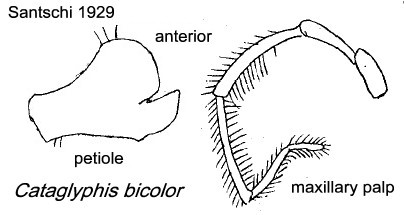 Fabricius's (1793) description is at Fabricius's (1793) description is at  . Foerster's (1850b) description of the
male fairmaieri is at . Foerster's (1850b) description of the
male fairmaieri is at  and and  . Foerster's (1850b) description of the megalocola
worker, is at . Foerster's (1850b) description of the megalocola
worker, is at  Emery (1906b: 184) gave an illustrated
comparative consideration, this is at Emery (1906b: 184) gave an illustrated
comparative consideration, this is at  . Karavaiev's (1912b) description of sudanicus
is at . Karavaiev's (1912b) description of sudanicus
is at  (Karavaiev refers to his 1911 paper but
there only the name appears, as "desertorum".
Crawley's (1920b) description of protuberatus
is at (Karavaiev refers to his 1911 paper but
there only the name appears, as "desertorum".
Crawley's (1920b) description of protuberatus
is at  .
Karavaiev's (1924) description of bellicosus
is at .
Karavaiev's (1924) description of bellicosus
is at  . .
|
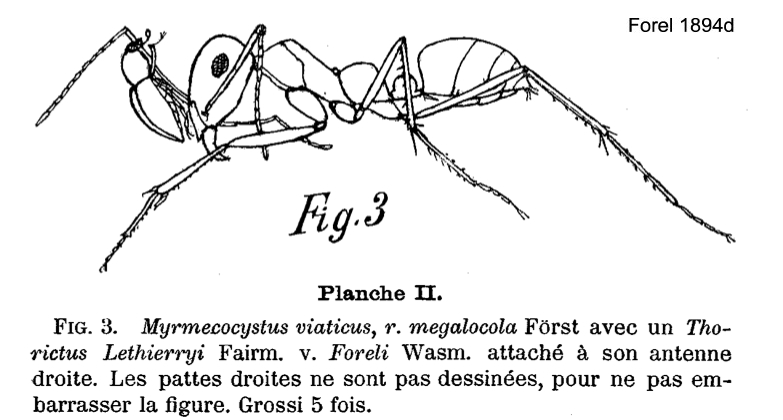 Bolton (1995) gave the
following - Bolton (1995) gave the
following -
Type location North Africa (Formica bicolor, Fabricius,
1793: 351, male); subspecies adustus (Santschi, 1929b: 43, all
forms) and oasium (Cataglyphis bicolor st nodus
var oasium, Santschi, 1929b: 46; Menozzi, 1932c: 95, all forms)
from Tunisia, basalis (Santschi, 1929b: 42, all forms)
from Algeria, bellicosus (Karavaiev, 1924: 307, worker)
from Iran, congolensis (Stitz, 1916: 396, illustrated,
worker) from Chad, protuberatus (Crawley, 1920b: 177,
worker) from Iraq, pubens (Santschi, 1929b: 43, all
forms) from Morocco, rufiventris (Emery, 1925b: 265,
worker) from Greece, seticornis (Myrmecocystus
bicolor ssp setipes variety seticornis, Emery,
1906d: 58, worker; the only mention in Wheeler, 1922) from Ghana,
and sudanicus (Karavaiev, 1912b: 590, illustrated, worker &
male [unavailable on HNS]) from Sudan; junior synonyms fairmairei
(Cat. fairmairei n. sp.,
Foerster, 1850b: 494, male), megalocola (Formica megalocola n. sp.,
Foerster, 1850b: 490,
worker; Emery, 1891b: 16, queen & male) and rotundinodis
(Karavaiev, 1912a: 16, worker) all from Algeria.
|
 Forel's
(1911d) note on rufiventris
simply noted differing from the ordinary form (of orientalis ??) in that the workers
have most of the first and second segments of the gaster reddish-brown.
It seems probable that this is a form of Cataglyphis viaticus. Forel's
(1911d) note on rufiventris
simply noted differing from the ordinary form (of orientalis ??) in that the workers
have most of the first and second segments of the gaster reddish-brown.
It seems probable that this is a form of Cataglyphis viaticus.
Santschi
(1929b) noted
adusta n var had the tarsi of major workers as of
a red-brown, darker than the alitrunk; the media workers are even
darker than the equivalent type media of the same size, from Tunisia;
basalis n var with the workers brighter red than the
type, the gaster black with the base of the first two segments reddish,
from Algeria and Tunisia;
pubens n var was of a clear red, the gaster black,
often slightly bronzed and less shiny than the type, the small workers
often are less dull, the head and alitrunk remaining red and only the
legs are brown, from Morocco, Algeria and Canary Is.
WORKER - Petiole nodiform, gaster raised in locomotion,
propodeum arched (from key to species-groups in Agosti, 1990). The bicolor
complex was given by Agosti as having bicoloured
workers which have appressed white to yellow pubescence on the hind
tibiae. He further noted the bicolor complex as known from
North Africa to Ivory Coast. The photograph (right) is from Hölldobler
& Wilson (1990).
|
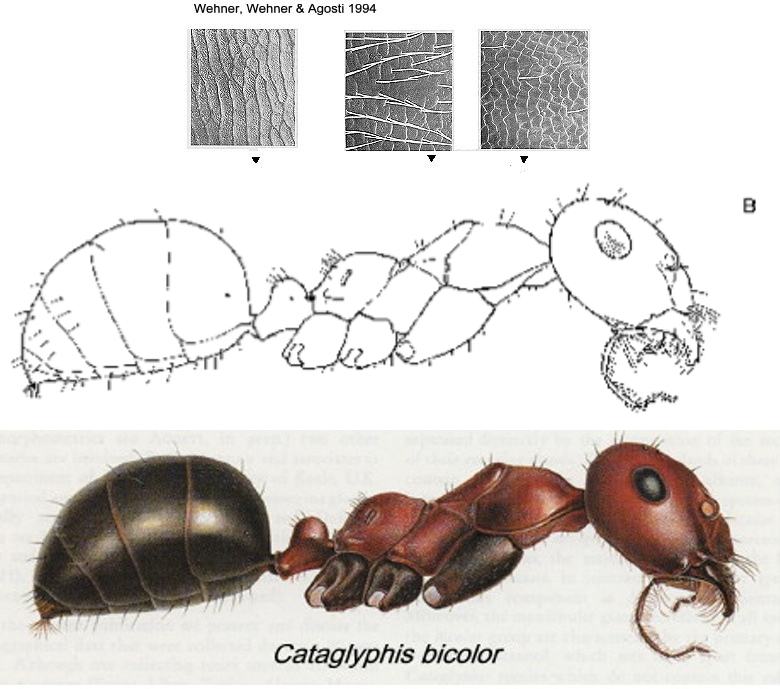 Wehner,
Wehner & Agosti (1994), however, separated Tunisian Cataglyphis
bicolor as - [bicolor, savignyi & viaticus]
petiole nodiform, 3rd & 4th segments of maxillary palp about equal
length; then, bicolor - head & alitrunk dark red, legs
often black, black erect hairs on occiput, black pubescence on hind
tibia. Wehner,
Wehner & Agosti (1994), however, separated Tunisian Cataglyphis
bicolor as - [bicolor, savignyi & viaticus]
petiole nodiform, 3rd & 4th segments of maxillary palp about equal
length; then, bicolor - head & alitrunk dark red, legs
often black, black erect hairs on occiput, black pubescence on hind
tibia.
They found also that bicolor prefers clayey soils, even heavy,
moist soils, whereas viaticus and savignyi are
distributed over more sandy areas.
|
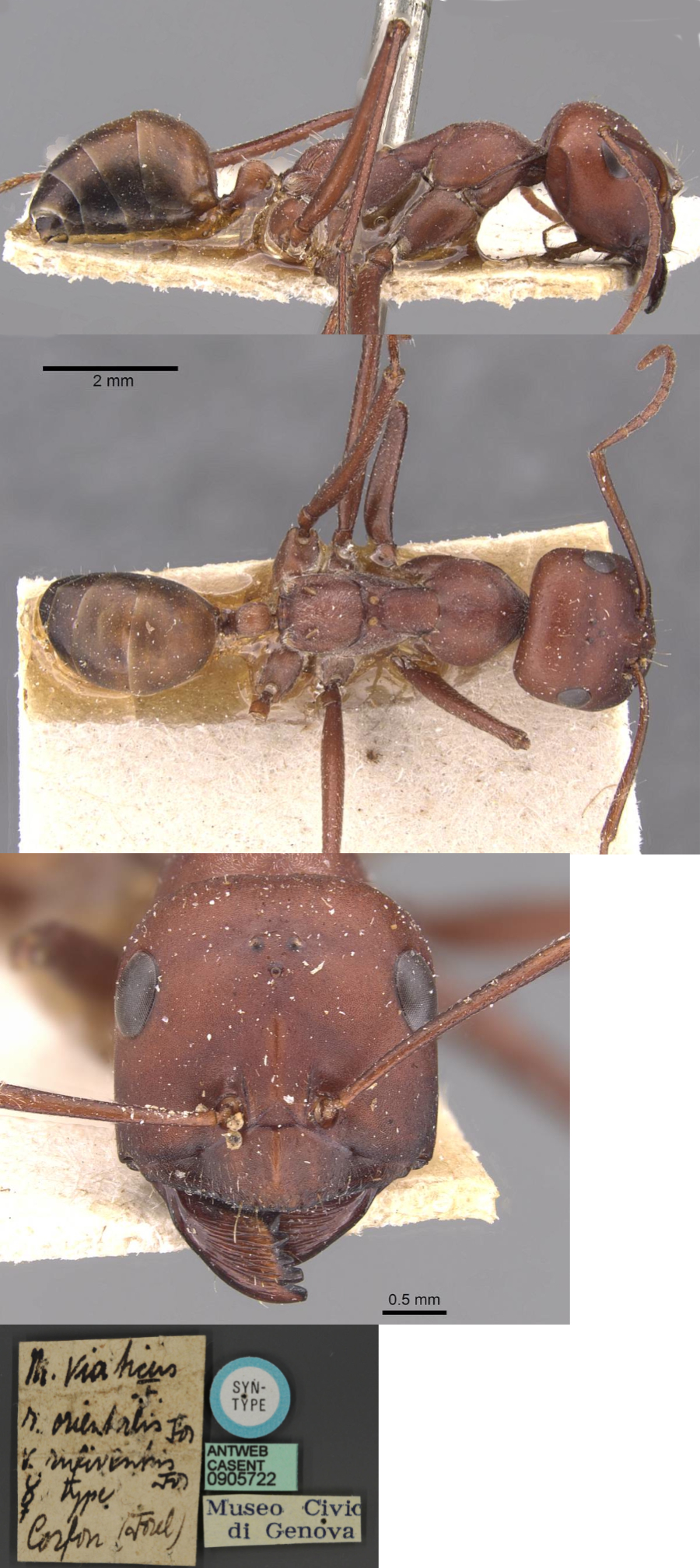 The
photomontage of a syntype worker of rufiventris
is collated from http://www.antweb.org/specimen.do?name=casent0905722 The
photomontage of a syntype worker of rufiventris
is collated from http://www.antweb.org/specimen.do?name=casent0905722
|
 The photomontage is of a
worker from Sudan,
Dilling; collector Zuheir Mahmoud (2009-70). The photomontage is of a
worker from Sudan,
Dilling; collector Zuheir Mahmoud (2009-70).
|
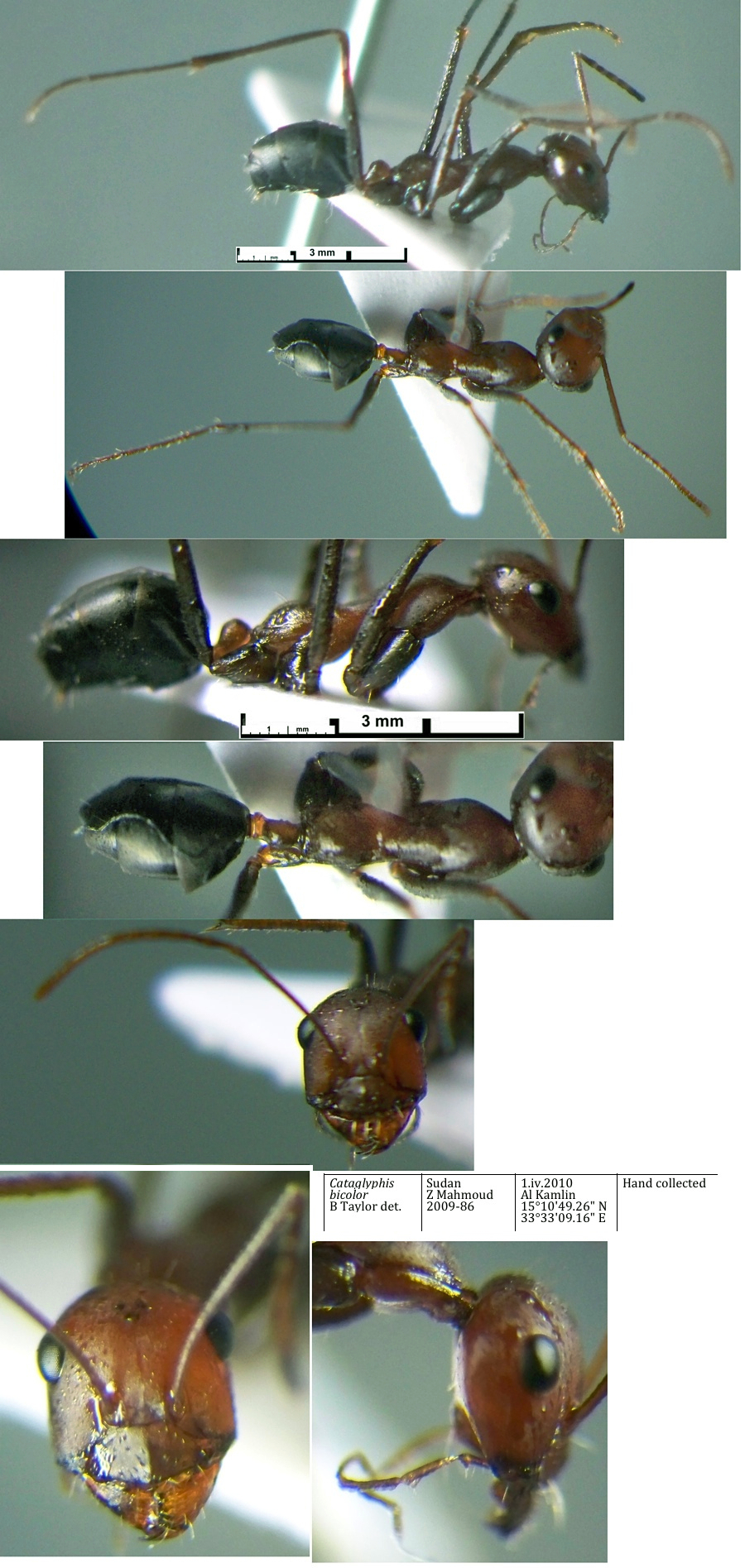 The photomontage is of a
worker from Sudan, Al Kamin; collector Zuheir Mahmoud
(2009-86). The photomontage is of a
worker from Sudan, Al Kamin; collector Zuheir Mahmoud
(2009-86).
|
|